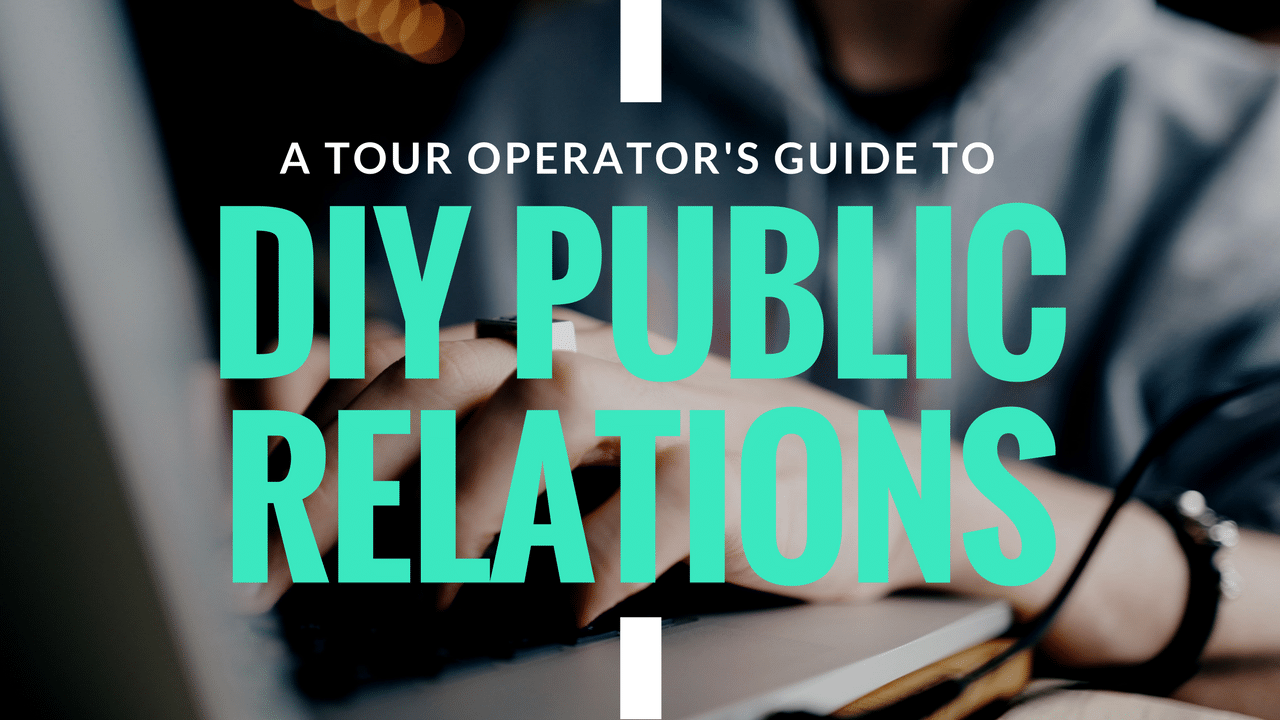
Working with a public relations firm is a great way to get your company the attention and recognition it deserves. For many tour and activity companies, though, that kind of professional partnership is out of reach.
If you can’t afford to spend much on PR, your company doesn’t have to languish in obscurity. While the pros have their advantages, you can set up a DIY public relationship campaign with minimal training and still see results.
Establish your goals
The first order of business when planning a PR campaign is to set yourself some goals. Do you want to raise awareness of your company? Do you want to promote a specific event? Or do you want to change your public image for the better?
Each of those goals requires a different strategy. To draw attention to your company as a whole, you’ll want to look at publications that profile small businesses and travel publications that cover your region. To promote a specific event, event announcements and listings in your target markets are a better approach. Changing your public image will take more than the right kind of publication — you’ll need to consider how best to align your company with the values you want to be associated with first, and then look at the sorts of publications that would highlight those efforts.
Read – a lot
There’s no way around it: research is a vital part of any DIY PR effort. You need to know who’s interested in companies or events like yours, and then you need to know what specific angles interest them. Read the publications you’d like to be profiled by. Read online communities for enthusiasts of the experiences you offer. Find out what the customers you’d like to reach are reading. Learn the sorts of things that capture their attention. Then figure out where your company and experiences might fit in.
Identify influencers
Once you’ve found your audience, figure out who they listen to. Are there specific bloggers or reporters that have a lot of influence in their communities? If you’re looking locally, are there newspapers or radio stations that appeal to the same demographics you want to reach — and if so, who’s covering the relevant beat? If you’re trying to grab the attention of young people, are there Instagrammers, YouTubers or other social media influencers they love? Is there an active Facebook group or Twitter hashtag that covers what you want to promote?
You don’t want to think as big as possible. You aren’t likely to be noticed by national news media unless you’re doing something unprecedented. Set your sights on influencers whose interest you may realistically be able to capture, and learn how to contact them.
This is one area where PR firms have a distinct advantage. They already have media lists and relationships with influencers. You’ll need to get more creative, but a word of caution: don’t be too much of a detective when looking people up. You want to reach them at their business email addresses or phone numbers — information that’s at least semi-publicly available, even if you have to dig a bit. If you happen to find someone’s private email address or phone number, don’t assume using it will be an advantage. Contacting someone at home is a good way to make someone very uncomfortable, and that’s a major blunder.
Craft your pitch
Since you’re planning to target your message at a few people who are most likely to pick it up rather than releasing it widely to an unfiltered media list, you have the advantage of being able to craft a personalized press release or pitch.
That doesn’t mean you should talk about their pets or family life (again, this comes back to the matter of comfort), but it does mean you should consider your audience. Read or watch the coverage they’re responsible for. Consider how they might cover your company in a way that would fit their style, and time your pitch with a bit of a lead before it will be relevant.
- A pitch should address the recipient by name, if at all possible — but don’t guess. If you’re sending to an organization and not a person, use a general, non-gendered greeting. If you can’t get more specific, try to address it to a role in the organization.
- Keep your pitch concise. You’ll only get a sliver of the recipient’s attention, so get your point across quickly and clearly. Your angle should be newsworthy, timely and relevant to the reader. Don’t just talk about your company, talk about the story that’s worth telling.
- Be confident, but not so confident that you sound like you’re doing them a favor. This is a reciprocal arrangement — you have a story idea that they’d benefit from telling, yes, but they’re well aware that you’ll benefit from them telling it.
- Include enough information that they understand the situation, but not so much they glaze over your email. A page is the absolute most you should include, and it should all be readable in the body of the email — attaching images is fine, but attaching your pitch or press release means it won’t be read. Extra details can be included in links to your company website.
- Proofread. Reporters aren’t teachers; they aren’t grading you on your grammar and spelling. But sloppy errors look unprofessional, and unprofessional pitches won’t be read. First impressions are absolutely vital when pitching, so have at least one other person read through your pitch or release before you send it.
- Let them know how to contact you. Again, you have very little of the recipient’s attention, so you don’t want to miss out on coverage because you neglected to include a phone number or email address where you can consistently be reached. Reporters aren’t going to hunt you down to tell your story.
- Come up with a great email subject line. This is the one thing that decides whether your pitch is ever opened, so it has to do a lot of heavy lifting. Unless you’re experienced, don’t try to get overly clever with deceptive or humorous subjects — just find the most interesting thing about your pitch and express it clearly and concisely.
All these points hold true if you’re writing a press release, but press releases also require a more formal structure that you should familiarize yourself with. WikiHow has a great guide with all the information you’ll need to structure a press release.
Wait patiently
This is the hardest part of doing your own PR. You went to so much effort to plan and craft the perfect pitch, you sent it out, and now… Nothing.
Unfortunately, that’s sometimes how even your best efforts will turn out, and there’s nothing you can do to change that. Reporters can get hundreds of pitches a day. They’re in no way obligated to cover your story, or even reply to your email. They may not even get in touch if they decide to run the story, so watch for it to show up on their website or in their magazine.
If it doesn’t, should you follow up? Maybe. If the story is important to you, and you truly believe it would be valuable to their readers, it’s worth tweeting after a couple days to let them know you sent something in, or emailing to highlight something particularly valuable. Don’t make any demands, don’t get pushy — just gently bring your story back to their attention one time.
If that doesn’t work, you need to let your pitch go. You can go back to the drawing board and try again with a stronger, more relevant pitch after a reasonable amount of time has passed. If you add value by making it a fresh, interesting pitch, most reporters won’t feel harassed. If you spam their inboxes with increasingly pushy copies of the same story, you’ll probably wind up on their blacklists.
Rinse and repeat
Press releases and pitches aren’t the only things PR firms handle, but some things really do require an expert touch. Effectively managing crises, arranging media training and organizing press conferences or publicity events are beyond the scope of DIY PR.
So find your outlets and your audience, plan your strategies, and craft your pitches. Earning media coverage takes practice. Don’t expect it to happen over night. You didn’t become a superstar tour or activity operator in a day, after all — but you’ve learned to be great at it with time, and you can do the same here.
Search The Blog
Categories
Most Popular Articles
- Set-jetting, Forest Bathing, and Hush Trips: 20 Innovative Tourism Business Ideas and Trends for 2023
- Get More Bookings With These 9 Tourism Website Essentials
- Advantages and Disadvantages of Online Travel Agencies (OTAs)
- Your Marketing Mix: the 7 Ps of Travel and Tourism Marketing
- How to Create a Business Plan for Your Tour or Travel Company





